By Antara Chowdhury
The 2022 NCR-Stat: Baseline Survey includes two questions related to environmental protection. [1] Survey participants in the North-Central Region (NCR) were asked what kind of pollution (air, water, or land pollution) bothers them most on a day-to-day basis and the extent of their concerns about climate change or global warming.
Pollution concerns
Figure 1 suggests that air pollution is the topmost concern for the respondents (42%) in the NCR. On the other hand, land pollution is the least concern among respondents (16%). Twenty percent of respondents are not concerned about pollution at all.
Figure 1: The kind of pollution that bothers respondents most on a day-to-day basis in the North Central Region (N=4,595)
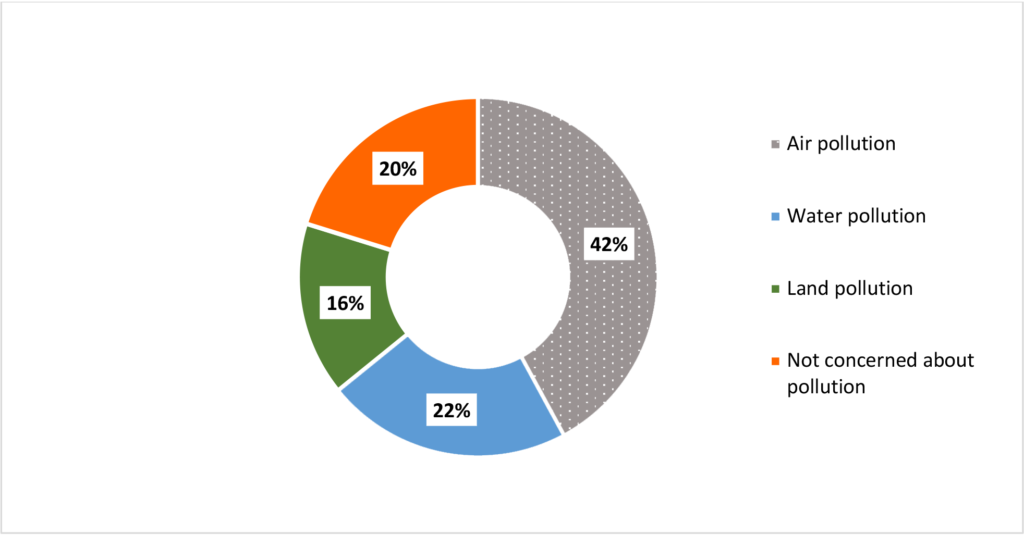
Source: Source: NCR-Stat: Baseline Survey, 2022
Figure 2 reflects the respondents’ pollution concerns based on their residential locations (urban, suburban, or rural). [2] Respondents living in urban and suburban areas show a similar level of concern about air, water, and land pollution. In contrast, respondents in rural areas have less air pollution concern but are more concerned about land and water pollution. In general, rural respondents are less concerned about environmental pollution compared to urban respondents.
Figure 2: Pollution concerns by respondents’ residential location across the North Central Region (N=4,586)
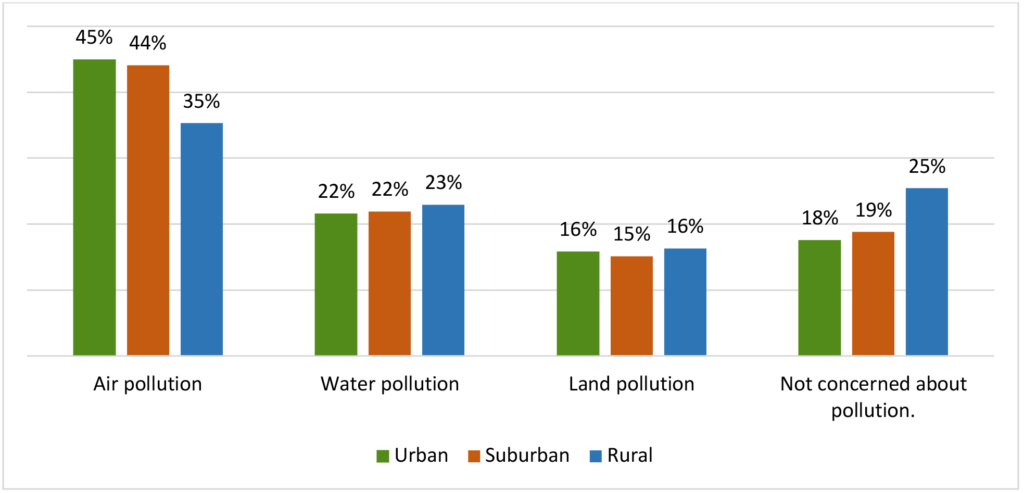
Source: NCR-Stat: Baseline Survey, 2022
Figure 3 indicates that Asian respondents have the highest share of those having concerns about air pollution. White respondents and respondents reporting two or more races show a similar amount of reluctance towards environmental pollution. Water pollution’ concerns of White and Blank respondents are similar.
Figure 3: Pollution concerns by respondents’ race across the North Central Region (N= 4,595)

Source: NCR-Stat: Baseline Survey, 2022
Non-Hispanic or Latino respondents show more concern about environmental pollution, especially land pollution, than Hispanic and or Latino respondents. On the other side, Hispanic or Latino respondents are more concerned about water pollution than Non-Hispanic or Latino respondents.
Climate change and global warming
NCR-Stat Baseline Survey also examined the survey respondents’ level of climate change and global warming awareness. The participants were asked to what extent they think climate change or global warming is an issue to be aware of.
Figure 4 shows that family households are more aware of climate change and global warming than non-family households. Fifty-four percent of family households reported a very great or great extent of their awareness compared to 49% of non-family households. Also, 22% of family households and 26% of non-family households showed very little or little awareness.
Figure 4: Climate change or global warming awareness by household type in the North Central Region (N=4,585)
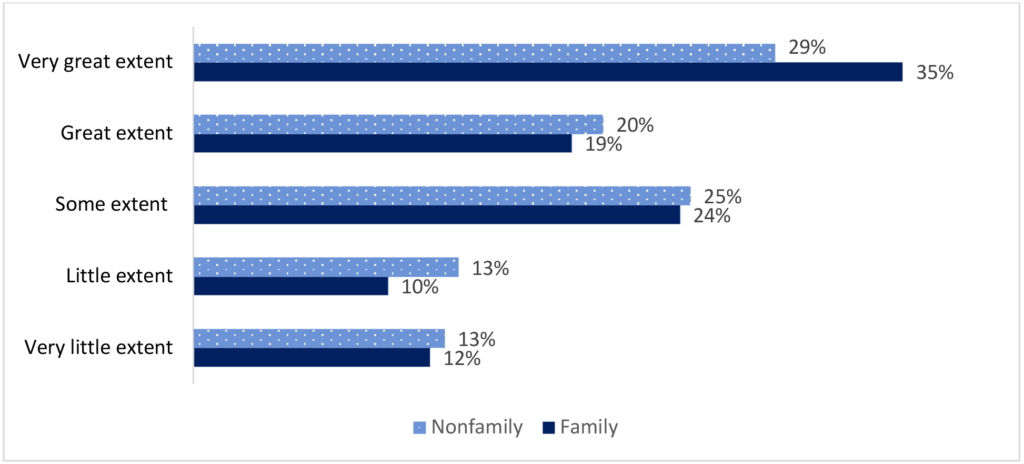
Source: NCR-Stat: Baseline Survey, 2022
The 12 NCR states were compared based on the share of respondents reporting a very great extent of climate change or global warming awareness. Thirty-four percent of respondents in Minnesota, Wisconsin, Michigan, and Iowa showed a very great extent of their awareness. In contrast, the lowest shares of respondents with a very great extent of awareness are North Dakota (12%) and South Dakota (19%).
Figure 5: Climate change or global warming awareness in the North Central Region by state (N=4,156)
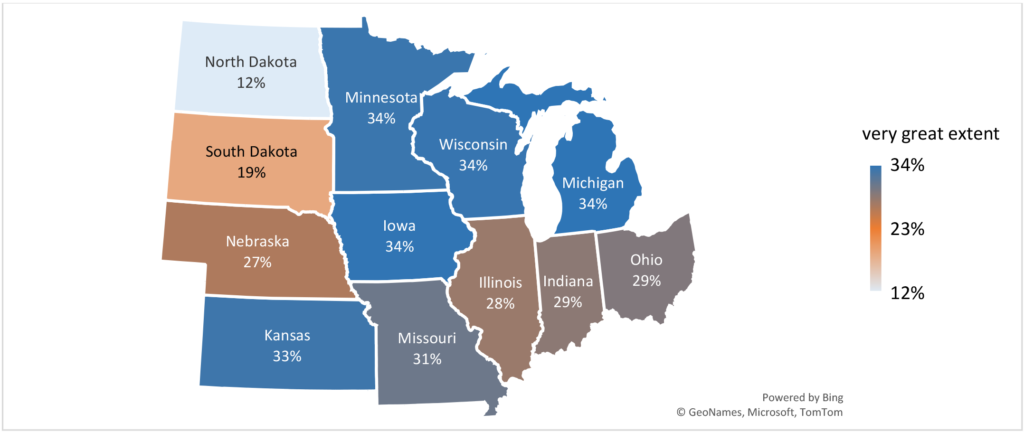
Source: NCR-Stat: Baseline Survey, 2022
Figure 6 indicates that climate awareness of suburban residents is higher compared to rural respondents. In contrast, the higher share of rural residents reported little or very little awareness than urban and suburban respondents.
Figure 6: Climate change or global warming awareness in the North Central Region by residential location (N=4,574)
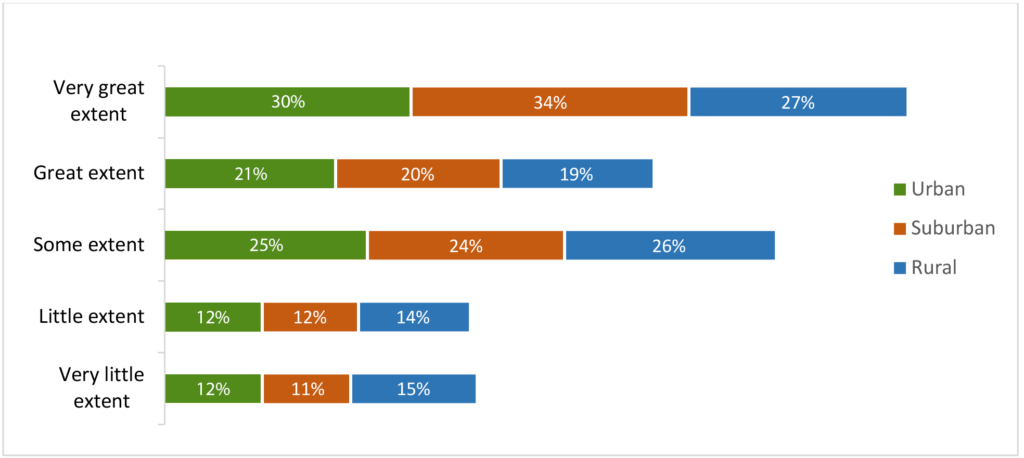
Source: NCR-Stat Baseline Survey, 2022
Conclusion
The data regarding pollution concerns and climate change awareness in the NCR show that air pollution is the most concerning pollution to the respondents, while water and land pollution are less concerning for them. All racial groups show the most concern about air pollution followed by water pollution. Family households reported higher concern about global warming and climate change compared to non-family households
References
[1] Bednarikova, Z.; Marshall, M. I.; Wiatt, R. D.; Wilcox, Jr, M. D. (2022). North Central Region Household Data (NCR-Stat): Baseline Survey. Purdue University Research Repository. doi:10.4231/2DEM-Z333
[2] We define an urban area as an urbanized area, such as a city, town, or metropolitan area; a suburban area as outskirts of a city or town, an outlying area economically tied to an urban area and within commuting distance; and a rural area as open and/or sparsely populated countryside, not within commuting distance to urban or suburban areas.
Author
Antara Chowdhury, Graduate Research Assistant, North Central Regional Center for Rural Development
Download article
Suggested citation
Chowdhury, A. (2023, March 14). Protecting Environment in the North Central Region. North Central Regional Center for Rural Development. https://ncrcrd.ag.purdue.edu/2023/03/14/protecting-environment-in-the-north-central-region/
